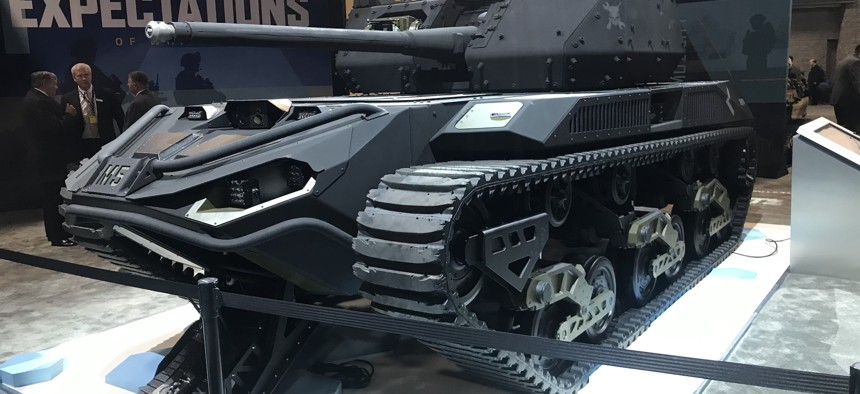
Ripsaw, a 10-ton, 20-foot electrically-powered treaded minitank, on display at AUSA Patrick Tucker
Weapons Makers Unveil A Herd of Robotanks— As the Army Worries about Battlefield Bandwidth
The U.S. Army is determined to field a mid-sized combat robot vehicle, but the prototypes are outstripping the datalinks that would connect them.
The show floor of the country’s biggest land-warfare convention was crowded with robot tanks this week, roughly two years after the U.S. Army’s declaration that its core 5-year priorities include a new combat vehicle. Among them, and with the greatest fanfare, Textron unveiled its Ripsaw, a 10-ton, 20-foot electrically-powered treaded minitank that can carry a small aerial drone on its back and can pop a smaller ground robot out of a front compartment. But companies from South Korea and Germany brought their own robo-battle machines to flaunt. Army leaders say that they’ve also been experimenting with battle concepts that combine soldiers, unmanned tanks, and small UAVs.
They’re also worried about getting all of those systems to link up and share massive amounts of data.
“The thing that keeps me up at night — well, nothing keeps me up at night, but the thing I think about often is the network,” Gen. John “Mike” Murray, the commanding general of the Army Futures Command, told reporters on Monday. “It’s not problems within the network, it’s that we’re relying on the network for so much”
Jeff Langhout, who runs the Army Combat Capabilities Development Command’s Ground Vehicles Systems Center, said that the Army recently ran an experiment in which two Bradley Fighting Vehicles were outfitted to command four roboticized M113 armored personnel carriers. While these are experiments show how far the Army and technology has come, he, too, has real worries about the network.
“There are some huge autonomy challenges,” Langhout said, “but I still think one of the greatest challenges we’re going to have is the network. On the ground, when you have robots wanting to talk to other robots, wanting to talk to ground vehicles and you go behind the hill, you go behind the rock, you go down in the gully; you’re in a city and you go around the corner of the building... Hey, we’re right here in Washington, D.C., how well does your cell phone work 100 percent of the time?” he asked.
The Army has had bad luck trying to institute large-scale data standards. Case in point: the Joint Tactical Radio System program spent $6 billion in a fruitless attempt to buy a single radio to serve all of its communications needs. In 2013, the U.S. military mandated the Commercial Mobile Device (CMD) Implementation Plan — essentially an effort to lower its data-transfer costs by using commercial networks for unclassified data. But as the current debate over 5G networking shows, even commercial cellular providers are having trouble getting ahead of what they see as future demand.
“This is commercial technology that everyone uses and relies on and so we are trying to take some of that and pass full-motion video in some cases. This is a big technological challenge and everyone is going to say, ‘I’ve got a radio that will do it.’ Fine, as long you’re 100 feet apart and can see each other. So that’s going to continue to be our biggest challenge because we just haven’t fixed the physics yet,” Langhout said.
Beyond its quest for semi-autonomous ground robots, the Army is looking into more and more data-intensive gear, such as the Integrated Visual Augmentation System, or IVAS, a set of augmented-reality goggles intended to give soldiers a lot of visual real time data to help with tasks like targeting during operations, and also with training and simulation during downtime. That’s also supposed to hook up with data feeds from tanks or other robots. But the rush to develop and field the newest tech concepts, and to integrate heavy amounts of data into all facets of operation, have driven the Army’s data needs skyward.
“Sensor to shooter? It’s the network. The synthetic training environment? It’s the network. IVAS is the network. If there’s one thing that’s cross cutting everything we’re working on, it’s the network,” said Murray. “The bandwidth requirements, the latency we can’t have, there’s a lot of technical hurdles to overcome with that.”
In a call with reporters, Textron officials said the Ripshaw’s open architecture would allow the Army to upgrade its communications and data networking as needed, as well as to incorporate higher levels of autonomy, as those capabilities emerged. They said that they had experimented with integrating ground and aerial robots with the Ripsaw, but not yet in a communications-denied environment, in part because the Army has not yet published their specific needs for future mid-sized robot combat vehicles.
Brig. Gen. Richard Coffman, director of the Army’s Next-Generation Combat Vehicle cross-functional team, said that robots may help extend solid data connectivity further afield, serving as flying or rolling cellular towers in a moving mesh network. “We’re also looking at unmanned vehicles to expand the network, to expand the line of sight so we can push these robots out as far as possible. So that they get in the riskiest places on earth and the soldier,” Coffman said.
In the meantime, the Army will work with the network it has until more capability comes online at a price it can afford. Said Murray, “You can’t just walk away from what you had because we invested a lot of money into the network. And so thickening, augmenting, improving the network with commercial solutions, and in two-year increments so you can capture the very best technology you possibly can.”
NEXT STORY: The Endless Aerial Surveillance of the Border




